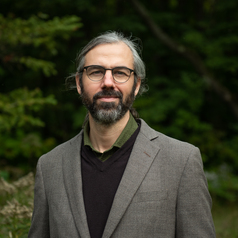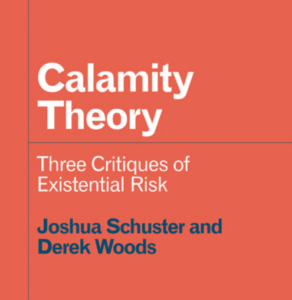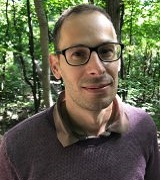What will the climate be like in the year 2500? Provocative new science: mid-West wheat fields transformed to tropical palms and grassland scrub where the mighty Amazon rainforest once stood. Lead author Chris Lyon takes us deeper into the future. Then the great escape: getting off the planet before existential risk ends the human experiment. “Calamity Theory” with author Joshua Schuster. Get in the time machine.
Listen to or download this Radio Ecoshock show in CD Quality or Lo-Fi
Listen to or download my 30 minute interview with scientist Christopher Lyon in CD Quality or Lo-Fi
Listen to or download my 30 minute interview with Joshua Schuster, author of “Calamity Theory” in CD Quality or Lo-Fi
DR. CHRIS LYON: CLIMATE TO 2500

The Amazon, now and in 2500. Artists rendition courtesy of Lyon et al. 2021
In Kim Stanley Robinson’s nonfiction sci-fi book “The Ministry for the Future”, 20 million in India died in a monster heat event. As a new project, a team at University of Leeds modeled and then made an artistic portrayal of India in the year 2500. People survive outside only in air-conditioned space suits.

Talk about inheritance! What kind of world are we leaving our grand-children? Does it matter if great-grand-children inherit a Hellish climate? Until now, the great engines of climate science have not tackled the longer future. Reports, treaties, and projections end at the year 2100. But no matter what we do, the world will keep on heating up, possibly beyond the limits of endurance for humans and crops. Certainly the sea will keep rising over shorelines and ports.
A study published in September 2021 takes us into the climate of 2200 right up to year 2500. After running the models for different scenarios, they engaged artists to show landscapes on the new hotter Earth. The Mid-West wheat regions become tropical by then. Drone machines harvest crops in the no-human-outside lands of India.
The paper is titled “Climate change research and action must look beyond 2100”. We reached the lead author, Dr. Christopher Lyon. He is from McGill University in Quebec, and a Visiting Research Fellow at the University of Leeds, UK. Lyon has published or co-authored several studies on Resiliency, including a case study in Scotland, Prepared for the Scottish Government Resilience Division.

Dr. Chris Lyon, McGill University and Visiting Scholar at University of Leeds
RESILIENCY – TO A POINT
After tens of thousands died in the European heat wave of 2003, governments around the world changed toward adaptation. With cooling centers, warnings, checking up on seniors, etc. the number of people dying in heat waves may actually go down for a decade or two. Human societies can adapt to growing heat up to a point. But what about the crops that keep billions of us alive? Chris talks to us about agricultural challenges after 2100.
Is there a point, for people in many nations, when “resiliency” means surviving mass movement toward the poles, or upward into mountain environments? Can developed nations stall for a century of two by burrowing underground, and technology like solar-powered air-conditioning? Are crops the real bottleneck where Earth can no longer sustain billions of humans and their livestock? Is the whole concept of “resiliency” becoming pointless over time?
As I look at Figure 3 in this paper, the central Tropical belt of Earth fills more and more with an angry red, representing temperatures too hot for humans to survive without support by machines, like air-conditioning. In the worst case, RCP6.0, it looks like up to a billion people will either experience mass death, mass migration, or both.
The paper by Lyon et al. says:
“By 2500 under RCP6.0, the proportion of the year exhibiting very strong heat stress is greater than 50% in much of Africa, the Amazon, the Arabian Peninsula, Southeast Asia, the Maritime Continent, and northern Australia. By contrast, today these regions experience this level of heat stress between 0% (Maritime Continent) and 25% (Arabian Peninsula) of the year. Many of these regions are only slightly less affected in RCP4.5 in this timeframe. In contrast, heat stress projections do not become substantially worse beyond 2100 in RCP2.6, showing the long-term advantages of climate mitigation”
PAUL VIRILIO PREDICTED MASS MIGRATION
On December 15, I posted my program on the French philosopher Paul Virilio. He foresaw this mass migration:
“Nearly one billion people will be displaced between now and 2040-2050… This is one of the most formidable events in the history of humankind: a repopulation. Like it or not, the migrant problem is not simply a problem of work, refugees, of this or that. This is about planetary repopulation. In 2000, the UN held a conference called ‘Repopulation Through Migration’… We will repopulate the world differently.”
Virilio, also a city planner (as he says in this video) predicts a great urban exodus, much bigger than the rural exodus of the 20th Century. He envisions:
“…a Europe without cities, without sedentarity, where everything is in flight and escapes – that is a first. So indeed we are talking about a censored word: deportation.”
Quotes come from “Conversation entre Raymond Depardon et Paul Virilio – 2008” on YouTube, at 2 min 56 sec.
We are reminded of the great spread of the human species somewhere around 200,000 years ago, fanning out from Africa to Asia and beyond. Once again, millions will move out of Africa, as surely as great tribes wandered out of Germany in the times of the late Romans, or the whites “repopulating” North America. All that is small compared to the repopulation already begun and swelling hugely as climate change continues.
HUGE LOSS OF CROP LANDS, AND CHANGES IN WHAT HUMANS EAT
The Lyon-led paper says:
“By 2500, declines in suitable regions for crop growth are projected to reach 14.9% (±16.5%) and 18.3% (±35.4%) for tropical and temperate crops, respectively (Figure 4; Table S2). These changes represent an additional six-fold decline in temperate crops and a near doubling of decline for tropical crops between 2100 and 2500. By contrast, if climate mitigation is assumed under RCP2.6, a decline of only 2.9% (±13.5%) is projected by 2500 for temperate crops, and an increase of 2.9% (±3.8%) is projected for tropical crops.”
“Wheat, potato, and cassava are projected to lose the greatest area for crop growth by 2500 (Figure 4; Table S2) under RCP6.0 across crop-growth calibrations. Conversely, soybean and maize are the only crops consistently projected to maintain or gain suitable area under RCP6.0 by 2500 across crop-growth calibrations”
THE END OF THE AMERICAN/CANADIAN BREADBASKET?

From the paper:
“BREADBASKET “US Midwest Breadbasket (a) 2020 and (b) 2500 under RCP6.0 scenario.”
“A characterization of the ‘breadbasket’ area of the US Midwest today and in 2500. In 2500, monocultured cereals may be replaced by a subtropical agroforestry of fictional plants (based on oil palms and arid zone succulents). Potential future water capture and irrigation devices can be glimpsed among the crops to offset the effects of extreme summer heat.
The interior plains of the American ‘Midwest’ are a global breadbasket. Today, the Midwest is characterized by cold winters and warm summers (Angel et al., 2018). Under RCP6.0, mean summer temperatures increase from 28°C today to 33°C by 2100 and 36°C by 2500 (Figure 2). Heat stress (measured with UTCI) increases in line with ambient temperature: 34.8°C in the warmest month today to 39.8°C in 2100, 42.9°C in 2200, and 44.9°C in 2500. With a definition of ‘very strong heat stress’ at UTCI >38°C, such a seasonal climate approaches levels that are physically stressful for humans and many other species.”
WE ARE COMMITTED NOW…
“Our projections past 2100 indicate that without rapid and significant reductions in greenhouse gas emissions, large areas of the Earth will change in ways that reduce their capacity to support large-scale human occupation. The long-term effects of 21st century warming will be felt for centuries to come, even if emissions are limited in the future.”
– Lyon et al. 2021
SIDE JOURNEY: UNIVERSAL THERMAL CLIMATE INDEX
Here is another term we all need to learn, to understand the impacts of climate change. Our paper (Lyon et al) says:
“We estimate changes in heat stress to 2500 using the Universal Thermal Climate Index (UTCI) (Blazjczyk et al., 2013; Jendritzky et al., 2012). UTCI is a measure of heat stress encompassing both fatal and physiologically stressful temperatures on a °C scale that reports the effects of climatic conditions on human physiological comfort, taking ambient temperature, humidity, solar and thermal radiation, and wind speed into account.”
See Also this EU data sheet on UTCI.
RESOURCES TO DIG FURTHER INTO SCIENCE OF COMING CENTURIES
Commentary on the paper by Chris A. Boulton
COMMENTARY Open Access “Looking to the (far) future of climate projection”
Radio Ecoshock interviewed Chris Boulton in 2015
BOULTON WARNS: CLIMATE TIPPING POINTS MAY COME AFTER 2100
(but we commit the climate to those changes now…)
“Climate tipping points, where changes in the external forcing of a system could cause large, often irreversible changes to its stability are possible (Lenton et al., 2008), without any changes in the system observed by 2100. One such tipping point concerns the dieback of the Amazon rainforest, but only in a few models is this observed by the end of the century due to drier conditions; in other models, the Amazon appears to remain stable, or even grow in biomass (Huntingford et al., 2013).
However, due to the slow dynamics of the vegetation, the forest may already be ‘committed’ to dieback, even if it appears stable in 2100 (Jones et al., 2009). Indeed, model studies have shown that without further emissions past 2100, allowing the climate system and in turn the Amazon rainforest to reach an equilibrium state, the condition of the forest could be greatly degraded (Boulton et al., 2017). With the rainforest acting as the world’s largest terrestrial sink, forest loss will have a huge impact on the global carbon cycle and thus future climate change.”
=================================================
JOSHUA SCHUSTER: CALAMITY THEORY
Call it “long-termism” or “effective altruism” but get ready for a ride. Big names like physicist Stephen Hawking and Elon Musk boost the cause. It sounds good at the start: we owe a duty to future humans and all intelligent life from animals to the octopus. In an apparently barren galaxy, we must at all costs prevent extinction of intelligent life on Earth. To do that, says Oxford philosopher Nick Bostrom, humans will merge with artificial intelligence, becoming transhuman. That new life form must, MUST, spread beyond this planet to populate other worlds.
Bostrom catalogs the most dire threats, from nuclear war through climate change to genetic tampering. Others get on board, like Australian philosopher Toby Ord, and Astronomer Royal Sir Martin Rees. Millions of dollars flow in from tech moguls like Bill and Melinda Gates and Peter Thiel. New institutions are founded such as The Sentience Institute, Oxford’s Centre for the Study of Existential Risk, and the Future of Life Institute at the University of Cambridge. I hope to cover existential risks more in a future Radio Ecoshock show.
That is where we start, at the bottom of a foggy future where post-humans inhabit a technical utopia in the stars. Is it real? Is it harmful or helpful to us now? Toby Ord, author of the influential book “The Precipice” told me he is too busy with other projects to appear on Radio Ecoshock. Nick Bostrom’s assistant says he is on leave until end of January. Bostrom is author of “Superintelligence: Paths, Dangers, Strategies”. Our audience is probably too small for him anyway. So we depend on two critics with views on ecology, justice, and what it means to be human, where we are, as we are.

Canadian academics Joshua Schuster and Derek Woods just published their book “Calamity Theory – Three Critiques of Existential Risk”. Dr. Schuster is author of “The Ecology of Modernism: American Environments and Avant-Garde Poetics”. He is currently on Sabbatical in France.


Co-authors of Calamity Theory Derek Woods and Joshua Schuster
For Nick Bostrom, humanity as we know it cannot be saved. We are completely obligated to transform ourselves into a new species, become “transhuman” and then “post-human” by merging with Artificial Intelligence and machines. Then we can enter a Utopia that lasts a billion years on a billion planets. It sounds so much like some New Age religions, or even old Messianic texts of Heaven and Hell.
In the existential risk crowd, climate change is a minor hiccup along the road, as long as it doesn’t wipe out humanity. We can tolerate all kinds of evil, from mass starvation to pandemics, as long as the core of science and technology continues, they say. Does that skew priorities for the substantial list of multi-billionaires who adopt Effective Altruism?
As Woods and Schuster tell us in the book “Calamity Theory”:
“The Future of Humanity Institute received 13.3 million pounds in funding from the Open Philanthropy Project in 2018, an effective altruism group primarily funded by Dustin Moskovitz, who cofounded Facebook with Mark Zuckerberg and three others. Skype cofounder Jaan Tallinn is also cofounder of the Boston-area Future of Life Institute, a think tank with ties to MIT devoted to studying AI safety and other technological extinction risks. Musk sits on the FLI scientific advisory board, and on a similar board at the Cambridge Centre.”
I would like to thank Andrew Kingham Murphie, PhD in Australia for the tip pointing me to this story.
And thank you to Ecoshock supporters, listeners who donate (once or monthly) to help me keep producing and distributing this program globally, free to all. If you can help, check this out.
I’m Alex Smith. Thank you for listening, and caring about our world.
AUDIO CREDITS: This show uses short clips from:
“In The Year 2525” (1969) by Zager & Evans – This is a remix by Venice Beat featuring Tess Timony
Stephen Hawking on our need to get off Earth – Courtesy of the Smithsonian
“Monkey’s Paw” (Laurie Anderson, Angels album) lyrics:
Well I stopped in at the Body Shop
Said to the guy:
I want stereo FM installed in my teeth
And take this mole off my back
And put it on my cheek
And uh…while I’m here, why don’t you give me
Some of those high-heeled feet?
And he said: Listen there’s no guarantee
Nature’s got rules and Nature’s got laws
But listen look out for the monkey’s paw
Neil Young: “After the Gold Rush” final verse
Well, I dreamed I saw the silver spaceships flying
In the yellow haze of the sun
There were children crying and colors flying
All around the chosen ones
All in a dream, all in a dream
The loading had begun
Flyin’ mother nature’s silver seed
To a new home in the sun
Flyin’ mother nature’s silver seed
To a new home
2500? Who knows? My rough guess is that those few humans remaining will probably be living underground 24/7 in modified old mine shafts/subterranean caverns (or purpose-built bunkers with geo-thermal energy) protecting them from the severely damaging UV of an ozone-depleted planet (sulfur dioxide build-up). Prime locations immune from sea level rise, may be such as the Tibetan Plateau.
They will need to recycle all water & the main source of food may be fungi & farmed edible invertebrates like worms/maggots biodegrading human waste & corpses (no plants/trees will survive on the surface).
Electricity (those without geothermal) may be from methane digesters or manpower-generated, utilising everlasting (!) lightbulbs & conserved with batteries. People will need regular sessions under UV-B lamps to maintain skin health & general wellbeing.
All this will severely deplete genetic health unless humans evolve to better survive such alien conditions.
As a counterpoint to the sickeningly reductive and abstract perspective of techno-utopian “futurists” mentioned herein, I would like to quote a passage – a much more life-affirming passage – from a seminal book everyone with a brain and and a conscience and an allegiance to actual life in an actual world should read. It is from the seminal work “The Unsettling of America: Culture & Agriculture” by Wendell Berry. The chapter from which this passage derives is called “The Body And The Earth”. (Written in 1977)
The question of human limits, of the proper definition and place of human beings within the order of Creation, finally rests upon our attitude toward our biological existence, the life of the body in this world. What value and respect do we give to our bodies? What uses do we have for them? What relation do we see, if any, between body and mind, or body and soul? What connections or responsibilities do we maintain between our bodies and the earth? These are
religious questions, obviously, for our bodies are part of the Creation, and they involve us in all the issues of mystery. But the questions are also agricultural, for no matter how urban our life, our bodies live by farming; we come from the earth and return to it, and so we live in agriculture as we live in flesh. While we live our bodies are moving particles of the earth, joined inextricably both to the soil and to the bodies of other living creatures. It is hardly surprising, then, that there should be some profound resemblances between our treatment of
our bodies and our treatment of the earth.
Apparently with the rise of industry, we began to romanticize the wilderness—which is to say we began to institutionalize it within the concept of the “scenic.” Because of railroads and improved highways, the wilderness was no longer an arduous passage for the traveler, but something to be looked at as grand or beautiful from the high vantages of the roadside. We became viewers of “views.” And because we no longer traveled in the wilderness as a matter of
course, we forgot that wilderness still circumscribed civilization and persisted in domesticity. We forgot, indeed, that the civilized and the domestic continued to depend upon wilderness—that is, upon natural forces within the climate and within the soil that have never in any meaningful sense been controlled
or conquered. Modern civilization has been built largely in this forgetfulness. And as we transformed the wilderness into scenery, we began to feel in the presence of “nature” an awe that was increasingly statistical. We would not become appreciators of the Creation until we had taken its measure. Once we
had climbed or driven to the mountain top, we were awed by the view, but it was an awe that we felt compelled to validate or prove by the knowledge of how high we stood and how far we saw. We are invited to “see seven states from atop Lookout Mountain,” as if our political boundaries had been drawn in red on the third morning of Creation.
We became less and less capable of sensing ourselves as small within Creation, partly because we thought we could comprehend it statistically, but also because we were becoming creators, ourselves, of a mechanical creation by which we felt ourselves greatly magnified. We built bridges that stood imposingly in titanic settings, towers that stood around us like geologic presences, single machines that could do the work of hundreds of people. Why, after all,
should one get excited about a mountain when one can see almost as far from the top of a building, much farther from an airplane, farther still from a space capsule? We have learned to be fascinated by the statistics of magnitude and power. There is apparently no limit in sight, no end, and so it is no wonder that our minds, dizzy with numbers, take refuge in a yearning for infinitudes of energy and materials.
And yet these works that so magnify us also dwarf us, reduce us to insignificance. They magnify us because we are capable of them. They diminish us because, say what we will, once we build beyond a human scale, once we conceive ourselves as Titans or as gods, we are lost in magnitude; we cannot control or limit what we do. The statistics of magnitude call out like Sirens to the statistics of destruction. If we have built towering cities, we have raised
even higher the cloud of megadeath. If people are as grass before God, they are as nothing before their machines.
If we are fascinated by the statistics of magnitude, we are no less fascinated by the statistics of our insignificance. We never tire of repeating the commonizing figures of population and population growth. We are entranced to think of ourselves as specks on the pages of our own overwhelming history. I remember that my high-school biology text dealt with the human body by listing its
constituent elements, measuring their quantities, and giving their monetary worth—at that time a little less than a dollar. That was a bit of the typical fodder of the modern mind, at once sensational and belittling—no accidental product of the age of Dachau and Hiroshima.
Pingback: Nuclear news this week – Australia and more | Nuclear Australia
Pingback: Surviving Marriage – Zodiacal Spiral